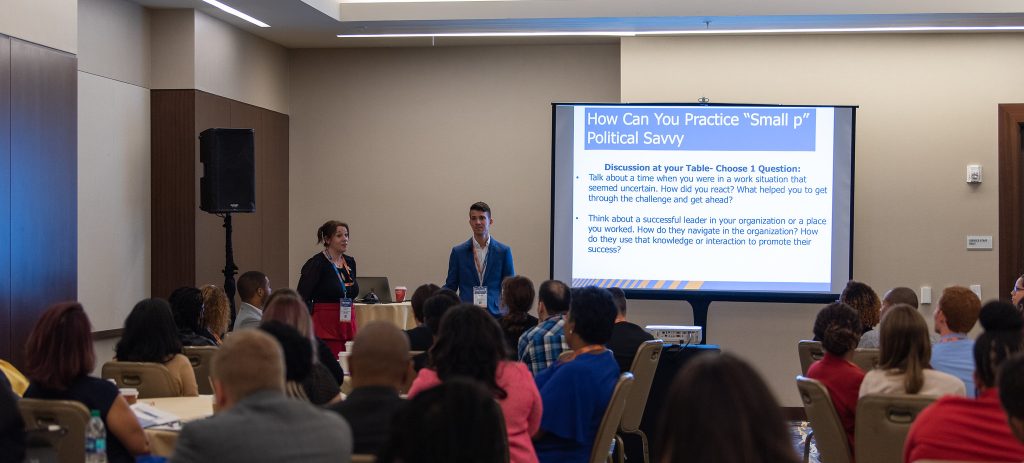Details matter. In government, every detail is part of a bigger picture, and employees are responsible for both the parts and the sum.
The nature of public sector work is politics, both with a “big P” and “small p.” “Big P” politics are the big picture motions, referring to the policy- and organization-level management of large workforces, policies and procedures. “Little p” politics are the small but important details, referring to the interpersonal, one-on-one elements of mission delivery for large organizations.
Navigating the bureaucratic waters of government requires political savvy. Arianne Gallagher, Program Manager for the Presidential Management Fellows Program at the Office of Personnel Management (OPM), and James Miceli, Executive Assistant to the Associate Chief Financial Officer for Financial Management at the Internal Revenue Service (IRS), spoke at the 2019 NextGen Government Training Summit about political savvy in both “small p” and “big P” situations, suggesting that the two often run parallel and having savvy in both contexts is key to a successful government career.
“Political savvy is one of the main leadership competencies that OPM defines,” Gallagher said.
Political savvy isn’t something that starts from the top or develops upward, Gallagher said. Instead, it’s something that individuals and leaders within organizations can take upon themselves.
Governed by politics, agencies host appointees who circle in and out of offices. Many times, they often join in a role that they have no experience in. For them, adapting to the culture and sensing the best way to go about implementing priorities throughout a workforce can be difficult, especially in a timely manner when terms are short.
Meanwhile, employees and existing structures can be blindsided if an appointee comes in heavy-handed. Drastic changes in policy – that sometimes directly conflict with the priorities and values of employees – can lead to disarray.
That’s where “big P” political savvy helps. While agencies and their workforces can’t decide who appointments are or what initiatives will be implemented, they can plan for what’s ahead, lend advice and ensure that agency values are maintained. It all starts with individuals.
An expert in political savvy, as defined by OPM, has several standout qualities. As per OPM proficiency levels for leadership competencies, the most qualified leader will serve as an intermediary between Congress, key stakeholders and leadership. Experts should also build bridges of communication and find shared priorities.
In preparing for the change of administration, the Office of Performance and Personnel Management exemplified “big P” political savvy, Gallagher said. By researching and analyzing the potential policies of candidates, gathering relevant questions and recommendations, and drafting implementation plans and timelines, they smoothed out the volatility of the most recent administration change.
“When I’m talking to my leaders or when I’m talking to other people, I already know what’s going on and have a sense of it,” Gallagher said, recommending that government employees subscribe to newsletters to keep up with the latest happenings. “Because my boss is coming in like, ‘Did you see the latest OPM article?’ And I’m like, ‘I saw it. I’m aware. Here are some things we could do to help increase morale after this comes out.’”
These conversations are a crucial part of political savvy, and they’re enabled by “little p” political savvy that allows positive ideas and dialogue to percolate up through organizations. Miceli recommended having regular two-way conversations about the organization for both bosses and lower-ranked employees.
In his own career, Miceli bounced around from different federal offices in different cities – a winding route in the face of layoffs – but was able to stay afloat on the advice of leaders and mentors, he said. Miceli said that from his boss, he’s learned the importance of supporting employees with “small p” politics, such as taking people out for lunch on their birthday or engaging in check-ins.
“That’s the kind of person you want to work for and that person will be supportive. And that person will help you improve that sort of ‘small p’ political vision for the organization,” Miceli said. He also said that having two mentors was also crucial him to learn how to manage the federal government landscape in both “big P” and “little p” terms.
The final recommendation Miceli gave attendees crossed the lines of political savvy. You have to be passionate about the mission of where you work, he said. Find someplace where other employees are as devoted to the goal as you are, he urged.
